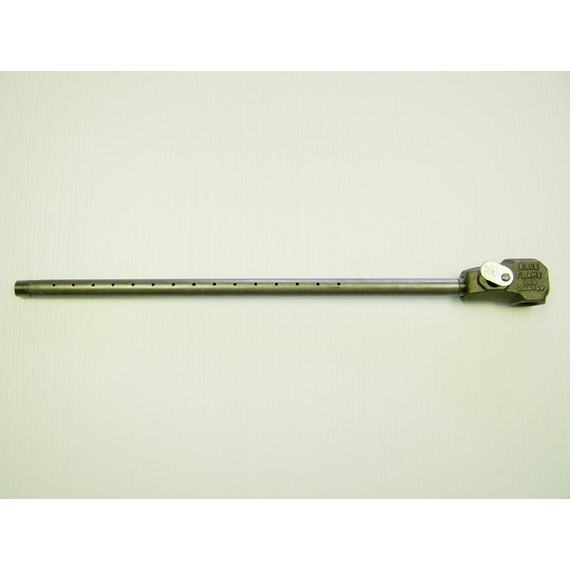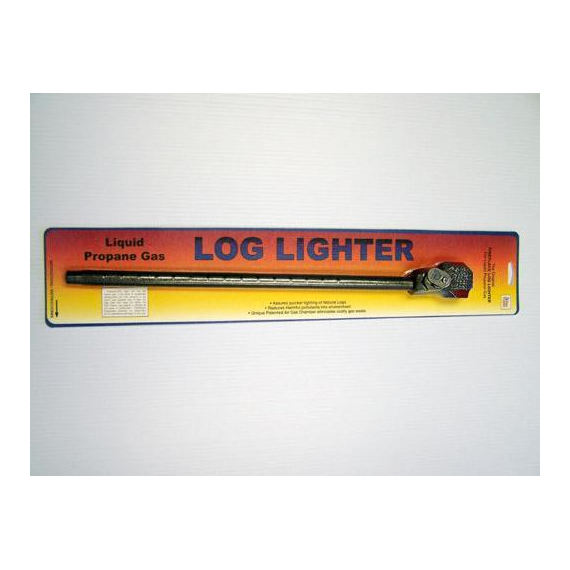Blue Flame 17 Inch Angled Log Lighter For Propane
For a quick and easy way to get your wood fire going, try using one of our Blue Flame 17 inch angled log lighters. Just turn on your propane going to the log lighter pipe, light your burner with a match, and flames from the pipe with start lighting the logs. In no time at all, the logs will catch fire and you can turn the propane off. In just a matter of a few minutes, your fire is burning! 17" long gas starter pipe has 1/2" pipe threads and installs easily. There are 15 pilot holes covering the length of the burner allowing the flame to quickly and evenly spread under the logs. The air and gas mixing chamber is designed to produce a more efficient burn.
INSTALLATION HAS TO BE PERFORMED BY A QUALIFIED INSTALLER, GAS SUPPLIER OR NFI CERTIFIED INSTALLER!
Navigating the Flame: Angled vs. Straight Log Lighters - Installation and Safety Guide
The allure of a crackling fire draws many to the comfort of their fireplace or wood-burning stove. Key to the swift ignition of this warmth is the log lighter, available in angled and straight designs. This article delves into the nuances of these styles, highlighting reasons to prefer one over the other, and provides a comprehensive guide for their installation, complete with safety precautions.
Angled vs. Straight Log Lighters:
Angled Log Lighters:
Design: Recognizable by a bent or angled pipe, typically set at a 45-degree angle.
Flame Direction: Angled design directs the flame toward the center of the firewood stack.
Advantages: Effective for reaching the interior of the firewood stack, ensuring a uniform ignition.
Straight Log Lighters:
Design: Features a straight pipe extending directly into the firebox.
Flame Direction: Flame follows a straight path along the length of the pipe.
Advantages: Simpler installation due to straightforward design while maintaining efficient log ignition.
Choosing Between Angled and Straight Log Lighters:
Fireplace Design: Consider your fireplace or wood-burning stove layout. If the design impedes a straight log lighter from reaching the center of the firewood stack, an angled log lighter may be more suitable.
Ease of Installation: For a streamlined installation process, a straight log lighter may be preferable due to its simplicity.
Personal Preference: Previous experiences and personal preferences may sway your decision. Stick with what has proven effective for you.
Installation Essentials and Safety Precautions:
Shut Off Gas Supply: Prioritize safety by turning off the gas supply to the fireplace before commencing installation.
Locate the Gas Line: Identify the gas line, typically situated behind the burner or within the firebox.
Connect the Log Lighter: Hard-pipe the log lighter into the firebox, connecting it securely to the gas line using proper fittings.
Secure the Log Lighter: Secure the log lighter in place using screws or fasteners provided by the manufacturer, ensuring stability.
Clearance from Firebox Floor: Adhere to local building codes and the manufacturer's recommendations for clearance from the firebox floor. A minimum 1/2" clearance to combustibles should be maintained within 6" of where the gas line passes through the side of the fireplace.
Flame Angle: For angled log lighters, aim for a flame angle of approximately 45 degrees, optimizing ignition. Adjust the log lighter accordingly.
Shut-Off Valve Placement: Install a shut-off valve within 6 feet of the firebox opening. Avoid placing any valve inside the firebox.
Safety Warnings: Ensure that the log lighter does not restrict airflow into the fireplace during use.
- Confirm that the chimney flue is open before attempting to operate the log lighter.
- Keep glass doors open while using the log lighter, and close the spark screen.
- Failure to observe these warnings may lead to possible injury.
Gas Line Installation: Gas controls must not be installed inside the fireplace. Shield controls to prevent overheating due to exposure to the wood fire. Maintain clearances from piping to combustible construction to avoid fire hazards.
Operating Instructions: Follow proper lighting and operation instructions. Ensure that the log lighter gas valve is in the OFF position before stacking logs on the fireplace grate.
The choice between angled and straight-log lighters hinges on factors such as your fireplace design, ease of installation preferences, and personal experiences. By following proper installation guidelines and safety precautions, you can ensure a safe, efficient, and enjoyable fire-starting experience. The log lighter, when chosen and installed wisely, becomes a reliable companion in creating the warmth and ambiance of a perfect fire.
Manufacturer's Warranty
NAPOLEON products are manufactured under the strict Standard of the world recognized ISO 9001 : 2008 Quality Assurance Certificate. NAPOLEON products are designed with superior components and materials assembled by trained craftsmen who take great pride in their work. The burner and valve assembly are leak and test-fired at a quality test station. The complete appliance is again thoroughly inspected by a qualifi ed technician before packaging to ensure that you, the customer, receives the quality product that you expect from NAPOLEON. The following materials and workmanship in your new NAPOLEON gas appliance are warranted against defects for as long as you own the appliance. This covers: combustion chamber, heat exchanger, stainless steel burner, phazer™ logs and embers, rocks, ceramic glass (thermal breakage only), gold plated parts against tarnishing, porcelainized enameled components and aluminum extrusion trims.* Electrical (110V and millivolt) components and wearable parts are covered and NAPOLEON will provide replacement parts free of charge during the fi rst year of the limited warranty. This covers: blowers, gas valves, thermal switch, switches, wiring, remote controls, ignitor, gasketing, and pilot assembly.* Labour related to warranty repair is covered free of charge during the fi rst year. Repair work, however, requires the prior approval of an authorized company offi cial. Labour costs to the account of NAPOLEON are based on a predetermined rate schedule and any repair work must be done through an authorized NAPOLEON dealer. * Construction of models vary. Warranty applies only to components included with your specifi c appliance. NAPOLEON GAS APPLIANCE PRESIDENT’S LIFETIME LIMITED WARRANTY
No reviews found





